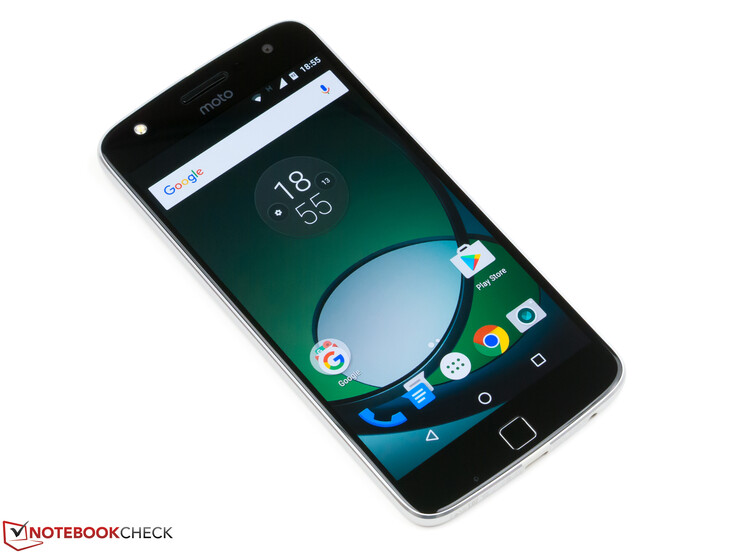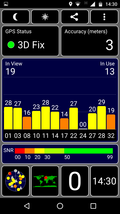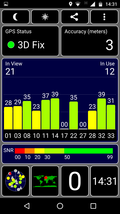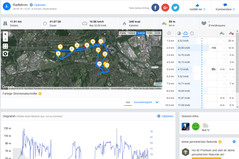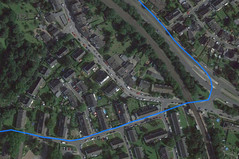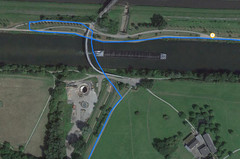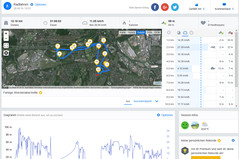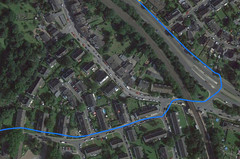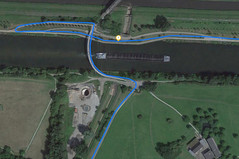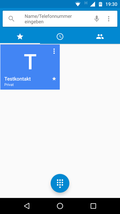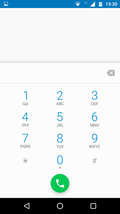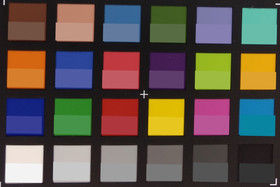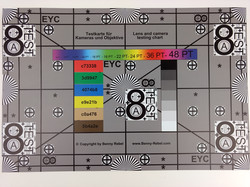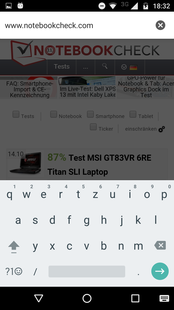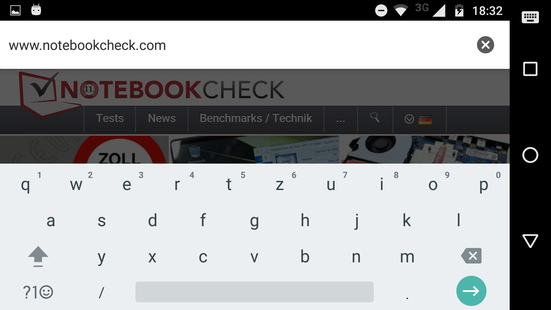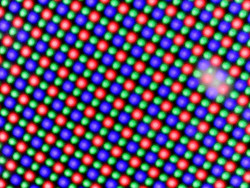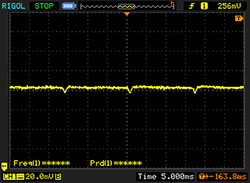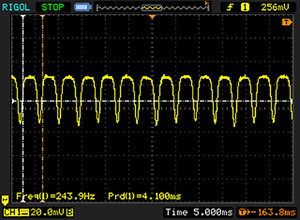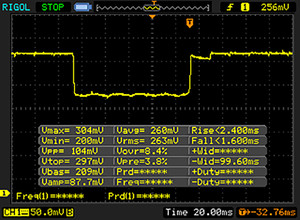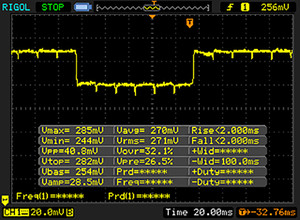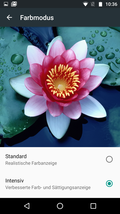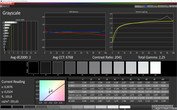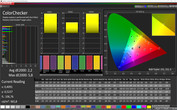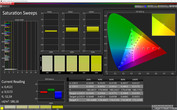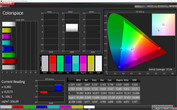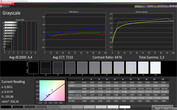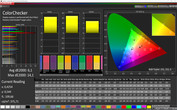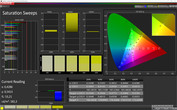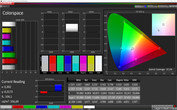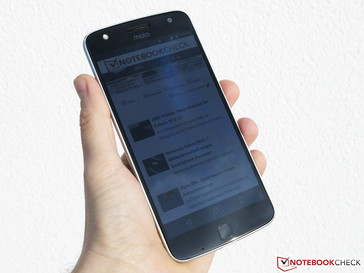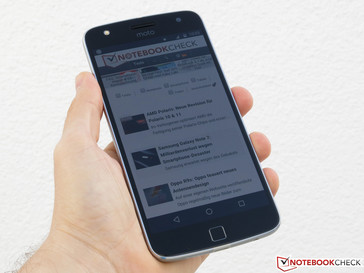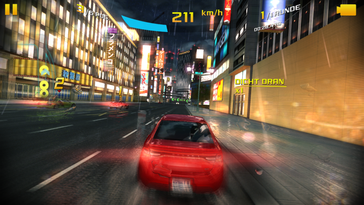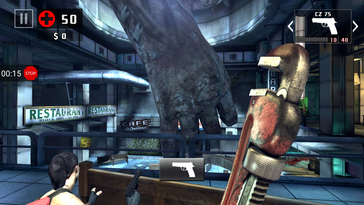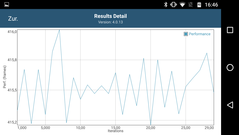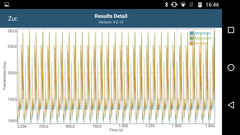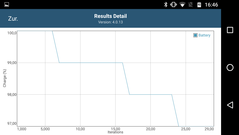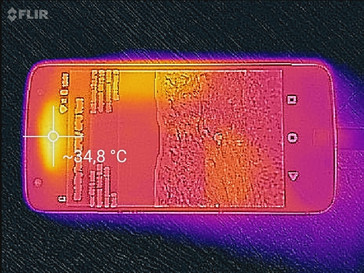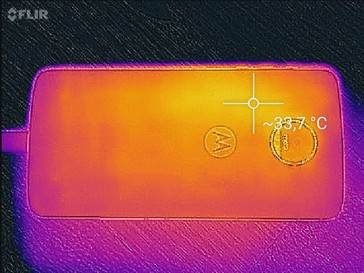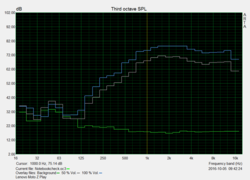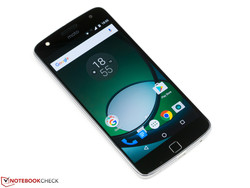Lenovo Moto Z Play Smartphone Review
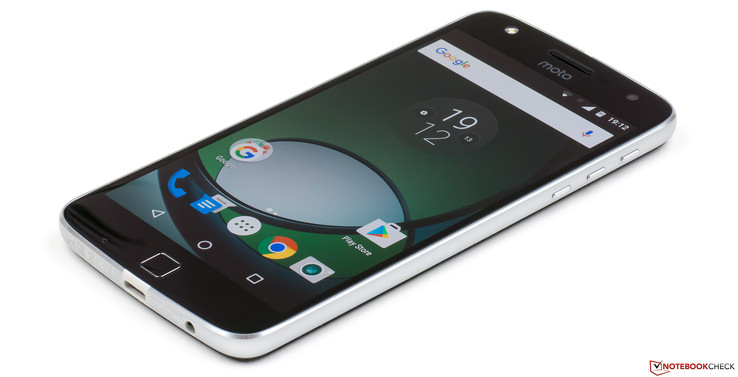
For the original German review, see here.
Lenovo offers the Moto Z Play mid-range model to customers who are interested in the manufacturer's new module concept, but do not want to spend 700 Euros (~$774) on a smartphone flagship. It is well-equipped with a modern Snapdragon 625 SoC, 3 GB of RAM, and 32 GB of internal storage, but it costs considerably less, starting at 449 Euros (~$496). Fans of a long battery life will be pleased with the relatively large 3510 mAh battery. The smartphone is available in black with a silver-colored bezel or white with a gold-colored bezel.
We compare the Moto Z Play with Samsung's Galaxy A5 2016, Sony's Xperia XA, and Huawei's P9 lite mid-range devices. Honor's 8 and OnePlus' 3 are available for roughly the same price - both being smartphones with high-end components. To clearly illustrate the differences of the review sample to its much higher-priced Moto Z sibling, we will also include this model in the comparison.
Case
The difference in height is probably the most striking difference between the Moto Z and Moto Z Play. While the extremely slim build is still a central design element in the first, the review sample looks rather bulky in direct comparison. In fact, its thickness of 7 millimeters (~0.3 in) is still slimmer than that of the rivals. However, it must be borne in mind that the primary camera protrudes by a significant 2.2 millimeters (~0.1 in). The included Style Shell in a nylon textile design can be attached to the back to even this out. It further increases the smartphone's thickness to approximately 9.2 millimeters (~0.36 in) and the weight from 165 (~5.8 oz) to 189 grams (~6.7 oz).
Generally, the smartphone is compatible with all Moto Mods so that, for example, the Insta-Share Projector or JBL Bass Boost speaker can be connected magnetically to the back. We have described both modules in detail in the review of the Moto Z. We have now had the opportunity to examine the Incipio offGRID power pack more closely. It can be fitted very well to the back, but increases the smartphone's weight to 249 grams (~8.8 oz) and the thickness to 13.4 millimeters (~0.53 in). The module's clearly tapered sides prevent the bundle from looking bulky. It is a shame that the smartphone is needed for recharging the power pack since it - unlike many other Moto Mods - does not have a USB port.
The Moto Z Play is basically on par with its more expensive sibling model in terms of build and choice of materials. Although glass and not metal is used on the back, it also feels high-quality and a pattern under it lightens the looks. The metal bezel's build is impeccable and conveys a very solid impression. Our warping attempts that did not affect the review sample confirm this. Furthermore, it is convenient that the casing has been treated with a water-repelling nano finish.
However, the Moto siblings have a few minor shortcomings in common: When a module is not attached, sensitive fingers can feel a somewhat sharp transition between the smartphone's bezel and back. The glass back of the Z Play also attracts fingerprints just as easily as the metal surface of the Moto Z.
Connectivity
While the higher-priced Moto Z was one of the first smartphones without a 3.5-mm audio jack, it is still present in the Moto Z Play. Fortunately, the USB Type-C port supports the USB 3.1 standard so that transmitting our "Big Buck Bunny" video from a PC to the smartphone was performed at approximately 70 MB/s. The available 23.1 GB of the 32 GB internal storage in the state of delivery can be filled quite fast. Furthermore, USB OTG for connecting external devices is supported.
Thanks to dual-SIM support, 2 SIM cards can be inserted alongside a microSD card in our configuration model. Which SIM is to be used for data connections can be selected in the settings. MicroSD cards with the current maximum capacity of 256 GB are supported (theoretically max. 2 TB). Furthermore, it can be formatted as a portable or internal storage. The first option has the advantage that data saved on the card remains readable for other devices, but apps cannot be installed on it then.
In addition to AC Wi-Fi with Wi-Fi Direct functionality, Bluetooth 4.0 and NFC are present for wireless connections. However, it is unfortunate that transmitting a wireless video signal is only possible via Chromecast and not via Miracast or the USB port.
Like its more expensive sister model, the Moto Z fades in the time and the latest notifications on the disabled screen via a hand gesture, but unlike the Moto Z it technically does not have infrared sensors. Consequently, the corresponding gestures are identified a bit less accurately. In any case, this feature functioned impeccably in the review sample. The same applies to the fingerprint sensor as it unlocked the smartphone reliably and quickly. A notification LED is not present.
Software
Continuing with the tradition, Lenovo has installed an only slightly modified Android operating system. In addition to various Google apps, we only find the Moto app. It allows configuring various convenience features such as activating the flashlight when it is shaken or launching voice recognition via a personal hot word.
The 32-bit version of Android 6.0.1 with security patches from July 2016 was preloaded on our review sample. This shows that Lenovo does not offer monthly updates, but that they are bundled in larger packages instead. Happily, Android Nougat has been announced for the Moto Play Z, which is due to appear this year.
Communication and GPS
As well as the usual GSM and 3G radio frequencies, the review sample also supports communicating via LTE in the bands common in Germany. Although Lenovo does not specify the maximum transmission rates, the integrated Snapdragon 625 SoC theoretically achieves up to 300 Mb/s in download and 150 Mb/s in upload.
In terms of Wi-Fi, some minor compromises have to be made compared with current premium models. The Moto Z Play still transmits via 802.11 a/b/g/n rather than the modern AC standard, and thus the connection supports 150 Mb/s at most. However, it is quite encouraging that the 5 GHz frequency band can be used. It showed an average transmission rate of 121 Mb/s when receiving and 112 Mb/s sending data with our Linksys EA8500 reference router. Thus, the Moto Z Play places itself just ahead of the Moto X Play that uses the same Wi-Fi standard. Nevertheless, these outcomes are far from the performance of the premium range competition in the form of OnePlus' 3 or Apple's iPhone 7. The Wi-Fi range did not give any reason for complaint. The Moto Z Play user can also fall back on NFC and Bluetooth 4.0 for near-field data transmission.
| Networking | |
| iperf3 transmit AX12 | |
| Apple iPhone 7 (Klaus I211) | |
| OnePlus 3 | |
| Huawei P9 | |
| Lenovo Moto Z Play | |
| Motorola Moto X Play | |
| Asus Zenfone 3 ZE552KL | |
| iperf3 receive AX12 | |
| Apple iPhone 7 (Klaus I211) | |
| OnePlus 3 | |
| Huawei P9 | |
| Lenovo Moto Z Play | |
| Motorola Moto X Play | |
| Asus Zenfone 3 ZE552KL | |
The Moto Z Play finds the current location quickly and with an accuracy of 3 meters (~10 ft) both indoors and outside. However, our bike test shows that the smartphone does not log the driven route quite as accurately as Garmin's Edge 500 GPS computer. Clear deviations become visible particularly in the area where we cross the bridge with the Moto Z Play. Overall, the deviations only add up to approximately 2% when looking at the entire route so that the accuracy should absolutely suffice for navigation purposes.
Telephone and Call Quality
While the Moto Z is equipped with 4 microphones, Lenovo has reduced these to 3 in the Moto Z Play. However, this does not affect the call quality via the earpiece. Like the higher-priced model, it is very good although a minor noise is audible at both ends. If at all, differences between the Moto siblings are only determinable in a direct comparison. The speaker's balanced sound of the Moto Z Play is pleasing in hands-free mode. However, it should not be turned up too high because the sound could distort slightly - depending on the contact's voice. A few syllables were dropped at sentence endings at the other end, but the Moto user was generally well understood.
Lenovo also relies on an unmodified standard Android design for the phone app. Thus, a screen for favorites, call list, keypad, and direct access to contacts is present. A search bar is also situated in the upper area.
Cameras
The front-facing camera in the Moto Z Play is identical to that of the one in the more expensive Moto Z. It has a resolution of 5 megapixels and an aperture of f/2.2, which produces decent selfies. The LED flash on the smartphone's front brightens up faces effectively in low-light situations. Videos can be recorded in Full HD resolution and convince with a good image quality that does not decrease too much in the indoors.
Lenovo uses a larger sensor than in the Moto Z for the primary camera of the Moto Z Play. Thus, the resolution climbs to 16 megapixels without affecting the image quality. The opposite is true: Daylight photos present far more details and show a much lower decrease in sharpness at the corners than the photos made with the high-end model (scene 1). Thus, the inevitable question of why is this camera not installed in the Moto Z arises. Besides the particularly slim build, the lack of an optical image stabilizer in the review sample is probably responsible for this. Photos recurrently blur in low-light situations. Furthermore, an extreme image noise is sometimes noticed in zoomed photos, which is filtered at the expense of details in the rivals. The camera's biggest shortcoming is seen when focusing objects: Despite the combination of laser and phase detection auto-focus, photos regularly blur (scene 2), which often cannot be resolved by determining a focal point on the smartphone's screen. If an impeccable result is required, the sharpness will have to be adapted manually in the camera app's professional mode.
The primary camera records videos at a maximum of 3840x2160 pixels and 30 frames per second. A mode for 60 frames per second is not present in any resolution. The image quality is very decent and can compete with that of the sister model. Although the electronic image stabilizer does not function as well as in the Moto Z, the auto-focus has been placed in a better position.
The smartphone's camera app can be launched directly from standby with a fast rotating motion of the hand. Besides the always preset full automatic, a manual mode is also present. It allows adapting diverse parameters, such as white balance, ISO values, and focal point. In addition it is also possible to record slow-motion videos and panned panoramas.
We test whether the primary camera in the Moto Z Play captures colors accurately by taking a photo of the X-Rite ColorChecker Passport in defined light conditions, which we compare with factual reference colors. The photos are not edited afterward, for example via manual white balance. Here, we see that some gray tones, as well as some colors, are slightly too dark. The bright color tones in the right upper edge of the comparison photo are most accurate.
Our photographed test chart illustrates just how well the lens' reproduction performance and the camera sensor's resolution capabilities are. The Moto Z Play does a much better job here than the Moto Z. The resolution is still quite high at the edges and even fine elements are still quite visible. However, minor elements are seen in some transitions when looking closer.
Accessories and Warranty
The Moto Z Play comes with a Style Shell in black nylon design and a 15-watt charger with fixed USB Type-C cable. Various brochures and a tool for opening the card slot are also included in the box. However, a headset is not included. Fortunately, all Moto Mods released to date are compatible with the review sample.
Lenovo ships the smartphone with only a one-year warranty. However, the mandatory legal two-year warranty http://www.notebookcheck.com/FAQ-Garantie-Gewaehrleistung-Rueckgaberecht.89911.0.htmlvia the respective seller applies in Germany. Please see our Guarantees, Return Policies & Warranties FAQ for country-specific information.
Input Devices and Handling
Google's standard keyboard is installed for entering texts. It is well developed and offers various convenience features, such as word suggestions and swipe inputting, as well as proprietary solutions. Recently, it has been possible to even customize the looks of the keyboard with different designs. Users who like to use voice control will be pleased with the personal Hotword option in the Moto app for launching the function.
The touchscreen in the Moto Z Play implements inputs very accurately especially since the fingers glide easily over the Gorilla Glass 4 surface. Overall, the smartphone makes a very fast impression in everyday use since apps open quickly and the contents rotate fast when the smartphone is turned. Furthermore, the fingerprint scanner that can also be used for turning off the screen is very reliable and fast. Also convenient: new notifications can be displayed without touching the smartphone; a hand gesture over the screen is enough to display them.
The physical keys are fitted quite firmly into the metal bezel and have a crisp pressure point. They cannot always be reached without repositioning the hand due to their location in the far upper right side.
Display
With a resolution of 1920x1080 pixels, the 5.5-inch screen in the review sample offers a slightly lower pixel density than the more expensive Moto Z. However, this difference is hardly visible to the naked eye, even in a direct comparison. The visible, thin color edges are at most sometimes more evident at the edges of objects on the smartphone.
Ehen the brightness is set manually, the Moto Z Play remains slightly below its potentials with a brightness of 356 cd/m² on a completely white screen. Enabling the ambient light sensor changes this to a top rate of 532 cd/m² under the same conditions. Up to 422 cd/m² is achieved when dark and bright areas are realistically distributed over the screen (Average Picture Level/APL50) with and without the sensor.
The underlying AMOLED screen technology also results in a black level of 0 cd/m². Consequently, the screen makes a very high-contrast impression. As mentioned in the review of the Moto Z, it is accompanied by flickering that is very perceptible for sensitive users. In the review sample this appears at a frequency of 243.9 Hz in a brightness setting of below 20%. However, flickering is still measurable at full brightness. The amplitude response is very flat so that fewer problems should occur despite the lower frequency of 60 Hz.
| |||||||||||||||||||||||||
Brightness Distribution: 93 %
Center on Battery: 509 cd/m²
Contrast: ∞:1 (Black: 0 cd/m²)
ΔE ColorChecker Calman: 2.2 | ∀{0.5-29.43 Ø4.78}
ΔE Greyscale Calman: 2 | ∀{0.09-98 Ø5}
Gamma: 2.25
CCT: 6768 K
| Lenovo Moto Z Play AMOLED, 1920x1080, 5.5" | Samsung Galaxy A5 2016 Super AMOLED, 1920x1080, 5.2" | Sony Xperia XA IPS, 1280x720, 5" | Huawei P9 Lite IPS, 1920x1080, 5.2" | Honor 8 IPS, 1920x1080, 5.2" | OnePlus 3 Optic-AMOLED, 1920x1080, 5.5" | Lenovo Moto Z AMOLED, 2560x1440, 5.5" | |
|---|---|---|---|---|---|---|---|
| Screen | |||||||
| Brightness middle (cd/m²) | 509 | 378 -26% | 518 2% | 505 -1% | 451 -11% | 419 -18% | 485 -5% |
| Brightness (cd/m²) | 511 | 380 -26% | 475 -7% | 468 -8% | 443 -13% | 431 -16% | 490 -4% |
| Brightness Distribution (%) | 93 | 91 -2% | 81 -13% | 88 -5% | 93 0% | 84 -10% | 92 -1% |
| Black Level * (cd/m²) | 0.61 | 0.74 | 0.4 | ||||
| Colorchecker dE 2000 * | 2.2 | 1.95 11% | 6.8 -209% | 4.1 -86% | 5.4 -145% | 4.1 -86% | 2.1 5% |
| Colorchecker dE 2000 max. * | 5.8 | 3.09 47% | 11.4 -97% | 5.8 -0% | 9.9 -71% | 12 -107% | 5.5 5% |
| Greyscale dE 2000 * | 2 | 1.86 7% | 7 -250% | 4.9 -145% | 6.7 -235% | 3.3 -65% | 2.6 -30% |
| Gamma | 2.25 98% | 2.13 103% | 2.35 94% | 2.5 88% | 2.33 94% | 2.1 105% | 2.23 99% |
| CCT | 6768 96% | 6376 102% | 8151 80% | 7116 91% | 8262 79% | 6550 99% | 6843 95% |
| Contrast (:1) | 849 | 682 | 1128 | ||||
| Color Space (Percent of AdobeRGB 1998) (%) | 89.38 | 88.14 | |||||
| Color Space (Percent of sRGB) (%) | 100 | 100 |
* ... smaller is better
Screen Flickering / PWM (Pulse-Width Modulation)
| Screen flickering / PWM detected | 243.9 Hz | ||
The display backlight flickers at 243.9 Hz (worst case, e.g., utilizing PWM) . The frequency of 243.9 Hz is relatively low, so sensitive users will likely notice flickering and experience eyestrain at the stated brightness setting and below. In comparison: 53 % of all tested devices do not use PWM to dim the display. If PWM was detected, an average of 8108 (minimum: 5 - maximum: 343500) Hz was measured. | |||
Display Response Times
| ↔ Response Time Black to White | ||
|---|---|---|
| 4 ms ... rise ↗ and fall ↘ combined | ↗ 2.4 ms rise | |
| ↘ 1.6 ms fall | ||
| The screen shows very fast response rates in our tests and should be very well suited for fast-paced gaming. In comparison, all tested devices range from 0.1 (minimum) to 240 (maximum) ms. » 15 % of all devices are better. This means that the measured response time is better than the average of all tested devices (20.2 ms). | ||
| ↔ Response Time 50% Grey to 80% Grey | ||
| 4 ms ... rise ↗ and fall ↘ combined | ↗ 2 ms rise | |
| ↘ 2 ms fall | ||
| The screen shows very fast response rates in our tests and should be very well suited for fast-paced gaming. In comparison, all tested devices range from 0.165 (minimum) to 636 (maximum) ms. » 14 % of all devices are better. This means that the measured response time is better than the average of all tested devices (31.6 ms). | ||
The screens of the Moto Z Play and Moto Z look absolutely identical at first glance when placed directly beside each other. Thus, it is not surprising that our CalMAN diagrams present similar rates. The average DeltaE deviation (grayscale) is 2 and (colors) 2.2 in the standard color mode - both are very good results that are within the ideal range (<3). The color temperature of 6768 K is also increased only slightly (ideal: 6500 K). The reproduction shifts marginally into the blue range when switching to the intensive mode, which results in a color temperature of 7210 K. The DeltaE deviations increase at the same time.
Although the screen in the Moto Z Play can hardly be discerned from the considerably more expensive Moto Z, there is a difference in direct comparison. The review sample's screen absorbs dark image details at a low screen brightness much faster than is the case in the sister model.
Performance
A highly advanced Snapdragon 625 SoC with eight power efficient Cortex A53 cores that clock at up to 2 GHz is inside the Moto Z Play. Its technical base is thus comparable with the Helio P10 in Sony's Xperia XA and the Kirin 650 in Huawei's P9 Lite. Since these two processors are still built in a structure width of 28 and 16 nanometers, the performance of the Snapdragon 625 (structure width: 14 nanometers) will be slightly better due to the potentially lower temperature development. An Adreno 506 GPU is responsible for video output in the review sample.
The Moto Z Play clearly outperforms the models from Samsung, Sony and Huawei in most benchmarks. The devices from OnePlus, Honor, and the Moto Z that are equipped with high-end components, however, usually have an uncatchable lead. An exception is seen in PCMark, though: The review sample can even reach the score of the strong Honor 8. Furthermore, the Xperia XA manages a slight lead on the Moto Z Play thanks to its screen's lower resolution in the onscreen graphic benchmarks.
| AnTuTu v6 - Total Score (sort by value) | |
| Lenovo Moto Z Play | |
| Samsung Galaxy A5 2016 | |
| Sony Xperia XA | |
| Huawei P9 Lite | |
| Honor 8 | |
| OnePlus 3 | |
| Lenovo Moto Z | |
| Geekbench 3 | |
| 32 Bit Multi-Core Score (sort by value) | |
| Lenovo Moto Z Play | |
| Samsung Galaxy A5 2016 | |
| 32 Bit Single-Core Score (sort by value) | |
| Lenovo Moto Z Play | |
| Samsung Galaxy A5 2016 | |
| 64 Bit Multi-Core Score (sort by value) | |
| Huawei P9 Lite | |
| OnePlus 3 | |
| Lenovo Moto Z | |
| 64 Bit Single-Core Score (sort by value) | |
| Huawei P9 Lite | |
| OnePlus 3 | |
| Lenovo Moto Z | |
| Geekbench 4.0 | |
| 64 Bit Multi-Core Score (sort by value) | |
| Lenovo Moto Z Play | |
| Honor 8 | |
| OnePlus 3 | |
| Lenovo Moto Z | |
| 64 Bit Single-Core Score (sort by value) | |
| Lenovo Moto Z Play | |
| Honor 8 | |
| OnePlus 3 | |
| Lenovo Moto Z | |
| Compute RenderScript Score (sort by value) | |
| Lenovo Moto Z Play | |
| Honor 8 | |
| OnePlus 3 | |
| Lenovo Moto Z | |
| PCMark for Android - Work performance score (sort by value) | |
| Lenovo Moto Z Play | |
| Samsung Galaxy A5 2016 | |
| Sony Xperia XA | |
| Huawei P9 Lite | |
| Honor 8 | |
| OnePlus 3 | |
| Lenovo Moto Z | |
| GFXBench (DX / GLBenchmark) 2.7 | |
| T-Rex Onscreen (sort by value) | |
| Lenovo Moto Z Play | |
| Samsung Galaxy A5 2016 | |
| Sony Xperia XA | |
| Huawei P9 Lite | |
| Honor 8 | |
| OnePlus 3 | |
| Lenovo Moto Z | |
| 1920x1080 T-Rex Offscreen (sort by value) | |
| Lenovo Moto Z Play | |
| Samsung Galaxy A5 2016 | |
| Sony Xperia XA | |
| Huawei P9 Lite | |
| Honor 8 | |
| OnePlus 3 | |
| Lenovo Moto Z | |
| GFXBench 3.0 | |
| 1920x1080 1080p Manhattan Offscreen (sort by value) | |
| Lenovo Moto Z Play | |
| Samsung Galaxy A5 2016 | |
| Sony Xperia XA | |
| Huawei P9 Lite | |
| Honor 8 | |
| OnePlus 3 | |
| Lenovo Moto Z | |
| on screen Manhattan Onscreen OGL (sort by value) | |
| Lenovo Moto Z Play | |
| Samsung Galaxy A5 2016 | |
| Sony Xperia XA | |
| Huawei P9 Lite | |
| Honor 8 | |
| OnePlus 3 | |
| Lenovo Moto Z | |
| GFXBench 3.1 | |
| 1920x1080 Manhattan ES 3.1 Offscreen (sort by value) | |
| Lenovo Moto Z Play | |
| Sony Xperia XA | |
| Huawei P9 Lite | |
| Honor 8 | |
| OnePlus 3 | |
| Lenovo Moto Z | |
| on screen Manhattan ES 3.1 Onscreen (sort by value) | |
| Lenovo Moto Z Play | |
| Sony Xperia XA | |
| Huawei P9 Lite | |
| Honor 8 | |
| OnePlus 3 | |
| Lenovo Moto Z | |
| 3DMark | |
| 1280x720 offscreen Ice Storm Unlimited Score (sort by value) | |
| Lenovo Moto Z Play | |
| Samsung Galaxy A5 2016 | |
| Sony Xperia XA | |
| Huawei P9 Lite | |
| Honor 8 | |
| OnePlus 3 | |
| Lenovo Moto Z | |
| 1280x720 offscreen Ice Storm Unlimited Graphics Score (sort by value) | |
| Lenovo Moto Z Play | |
| Samsung Galaxy A5 2016 | |
| Sony Xperia XA | |
| Huawei P9 Lite | |
| Honor 8 | |
| OnePlus 3 | |
| Lenovo Moto Z | |
| 1280x720 offscreen Ice Storm Unlimited Physics (sort by value) | |
| Lenovo Moto Z Play | |
| Samsung Galaxy A5 2016 | |
| Sony Xperia XA | |
| Huawei P9 Lite | |
| Honor 8 | |
| OnePlus 3 | |
| Lenovo Moto Z | |
| 2560x1440 Sling Shot OpenGL ES 3.0 Physics (sort by value) | |
| Lenovo Moto Z Play | |
| Samsung Galaxy A5 2016 | |
| Sony Xperia XA | |
| Huawei P9 Lite | |
| Honor 8 | |
| OnePlus 3 | |
| Lenovo Moto Z | |
| 2560x1440 Sling Shot OpenGL ES 3.0 Graphics (sort by value) | |
| Lenovo Moto Z Play | |
| Samsung Galaxy A5 2016 | |
| Sony Xperia XA | |
| Huawei P9 Lite | |
| Honor 8 | |
| OnePlus 3 | |
| Lenovo Moto Z | |
| 2560x1440 Sling Shot OpenGL ES 3.0 (sort by value) | |
| Lenovo Moto Z Play | |
| Samsung Galaxy A5 2016 | |
| Sony Xperia XA | |
| Huawei P9 Lite | |
| Honor 8 | |
| OnePlus 3 | |
| Lenovo Moto Z | |
The same order is seen in the browser tests as in the benchmark apps: The Moto Z Play is faster than smartphones from the same performance category, but it does not come close to the high performance level of the Honor 8, the OnePlus 3, and the Moto Z rivals that are equipped with high-end processors.
However, this is not relevant subjectively. Browsing with the Moto Z Play is very smooth and does not involve long waiting times.
| Mozilla Kraken 1.1 - Total (sort by value) | |
| Lenovo Moto Z Play | |
| Samsung Galaxy A5 2016 | |
| Sony Xperia XA | |
| Huawei P9 Lite | |
| Honor 8 | |
| OnePlus 3 | |
| Lenovo Moto Z | |
| Octane V2 - Total Score (sort by value) | |
| Lenovo Moto Z Play | |
| Samsung Galaxy A5 2016 | |
| Sony Xperia XA | |
| Huawei P9 Lite | |
| Honor 8 | |
| OnePlus 3 | |
| Lenovo Moto Z | |
| WebXPRT 2015 - Overall (sort by value) | |
| Lenovo Moto Z Play | |
| Samsung Galaxy A5 2016 | |
| Sony Xperia XA | |
| Huawei P9 Lite | |
| Honor 8 | |
| OnePlus 3 | |
| Lenovo Moto Z | |
| JetStream 1.1 - Total Score (sort by value) | |
| Lenovo Moto Z Play | |
| Samsung Galaxy A5 2016 | |
| Sony Xperia XA | |
| Huawei P9 Lite | |
| Honor 8 | |
| OnePlus 3 | |
| Lenovo Moto Z | |
* ... smaller is better
The internal storage in the Moto Z Play is not bad at all. All comparison devices, except for the Moto Z sibling, are outperformed especially in random write. However, the review sample also surpasses many mid-range models in the other tests. Only in sequential write can it hardly outpace these, but it still achieves a good outcome with 254.78 MB/s. Furthermore, the memory card's interface is the best in the comparison field together with that of the Moto Z. We determine a read rate of 74.58 MB/s and a write rate of 50.57 MB/s with our Toshiba Exceria Pro M401 (THN-M401S0640E2, UHS-I Class 3, max. read: 95 MB/s, max. write: 80 MB/s) reference card.
| Lenovo Moto Z Play | Samsung Galaxy A5 2016 | Sony Xperia XA | Huawei P9 Lite | Honor 8 | OnePlus 3 | Lenovo Moto Z | |
|---|---|---|---|---|---|---|---|
| AndroBench 3-5 | -38% | -22% | -27% | -11% | 91% | 77% | |
| Random Read 4KB (MB/s) | 38.78 | 22.9 -41% | 22.05 -43% | 38.22 -1% | 34.16 -12% | 137.6 255% | 117.2 202% |
| Random Write 4KB (MB/s) | 45.58 | 11.2 -75% | 10.6 -77% | 15.35 -66% | 31.5 -31% | 18.23 -60% | 74.9 64% |
| Sequential Write 256KB (MB/s) | 73.1 | 60.4 -17% | 68.6 -6% | 46.24 -37% | 119.3 63% | 153.3 110% | 168.3 130% |
| Sequential Read 256KB (MB/s) | 254.8 | 209.4 -18% | 240.4 -6% | 283.5 11% | 247.5 -3% | 408.7 60% | 439.7 73% |
| Sequential Write 256KB SDCard (MB/s) | 50.6 | 50.7 0% | 25.1 -50% | 23.59 -53% | 45.64 -10% | ||
| Sequential Read 256KB SDCard (MB/s) | 74.6 | 72.9 -2% | 60.8 -18% | 53.7 -28% | 78.5 5% |
Games
An Adreno 506 graphics unit takes care of gaming fun in the Moto Z Play. Thanks to the now almost moderate Full HD resolution, the performance is enough even for displaying smooth images at high graphics quality in hardware-driven games such as "Asphalt 8" or "Dead Trigger 2".
Both the touchscreen and internal sensors function impeccably in gaming routine, and the front-sided speaker entertains with its appealing sound backdrop.
| Asphalt 8: Airborne | |||
| Settings | Value | ||
| high | 30 fps | ||
| very low | 30 fps | ||
| Dead Trigger 2 | |||
| Settings | Value | ||
| high | 56 fps | ||
Emissions
Temperature
The Moto Z Play stays cool even during permanent load. With surface temperatures of at most 34.5 °C (~94 °F) in the speaker's area and 27.7 °C (~82 °F) on the back, it hardly heats up. This places it at the top position among the rivals, which all exceed 40 °C (~104 °F) except for Samsung's Galaxy A5 2016.
The GFXBench battery test reveals whether this great performance is due to the efficiency of the Snapdragon 625 SoC or whether Lenovo has decided to throttle the performance at an early stage. It performs the Manhattan test thirty times in succession and logs the achieved performance as well as the battery state in every run. Fortunately, the frame rates are very stable so that the minor temperature increase is not accomplished via throttling.
(+) The maximum temperature on the upper side is 34.5 °C / 94 F, compared to the average of 35.2 °C / 95 F, ranging from 21.9 to 247 °C for the class Smartphone.
(+) The bottom heats up to a maximum of 32.7 °C / 91 F, compared to the average of 34 °C / 93 F
(+) In idle usage, the average temperature for the upper side is 28.5 °C / 83 F, compared to the device average of 32.9 °C / 91 F.
Speaker
As known from the Moto Z, the speaker in the Moto Z Play is also incorporated in the earpiece. In line with its name, the review sample plays music in good quality and at a fairly high volume. We measure up to 88.13 dB(A) in the Pink Noise test, which is considerably more than in the higher-priced sister model. Furthermore, tones ranging from 200 to 400 Hz are rendered somewhat better, which results in a relatively balanced sound for smartphone conditions. If this is not adequate, the user can attach the JBL Sound Boost module to the Moto Z Play's back. It is much louder at up to 95.2 dB(A).
The 3.5-mm jack transmitted an impeccable audio signal without static in the test.
Lenovo Moto Z Play audio analysis
(+) | speakers can play relatively loud (88.1 dB)
Bass 100 - 315 Hz
(-) | nearly no bass - on average 28.9% lower than median
(±) | linearity of bass is average (8.3% delta to prev. frequency)
Mids 400 - 2000 Hz
(±) | reduced mids - on average 5.2% lower than median
(+) | mids are linear (4.7% delta to prev. frequency)
Highs 2 - 16 kHz
(+) | balanced highs - only 1.9% away from median
(+) | highs are linear (1.4% delta to prev. frequency)
Overall 100 - 16.000 Hz
(±) | linearity of overall sound is average (17.9% difference to median)
Compared to same class
» 15% of all tested devices in this class were better, 8% similar, 76% worse
» The best had a delta of 11%, average was 35%, worst was 134%
Compared to all devices tested
» 36% of all tested devices were better, 8% similar, 56% worse
» The best had a delta of 4%, average was 24%, worst was 134%
no name audio analysis
(+) | speakers can play relatively loud (95.2 dB)
Bass 100 - 315 Hz
(±) | reduced bass - on average 11.6% lower than median
(±) | linearity of bass is average (7.4% delta to prev. frequency)
Mids 400 - 2000 Hz
(+) | balanced mids - only 2.7% away from median
(+) | mids are linear (2.6% delta to prev. frequency)
Highs 2 - 16 kHz
(+) | balanced highs - only 2.4% away from median
(+) | highs are linear (3.8% delta to prev. frequency)
Overall 100 - 16.000 Hz
(+) | overall sound is linear (10.5% difference to median)
Compared to same class
» 5% of all tested devices in this class were better, 1% similar, 94% worse
» The best had a delta of 4%, average was 24%, worst was 134%
Compared to all devices tested
» 5% of all tested devices were better, 1% similar, 94% worse
» The best had a delta of 4%, average was 24%, worst was 134%
Lenovo Moto Z audio analysis
(+) | speakers can play relatively loud (83.9 dB)
Bass 100 - 315 Hz
(-) | nearly no bass - on average 34.4% lower than median
(±) | linearity of bass is average (8.2% delta to prev. frequency)
Mids 400 - 2000 Hz
(±) | reduced mids - on average 5.4% lower than median
(+) | mids are linear (6% delta to prev. frequency)
Highs 2 - 16 kHz
(+) | balanced highs - only 2.3% away from median
(+) | highs are linear (1.8% delta to prev. frequency)
Overall 100 - 16.000 Hz
(±) | linearity of overall sound is average (23.5% difference to median)
Compared to same class
» 53% of all tested devices in this class were better, 8% similar, 39% worse
» The best had a delta of 11%, average was 35%, worst was 134%
Compared to all devices tested
» 69% of all tested devices were better, 6% similar, 24% worse
» The best had a delta of 4%, average was 24%, worst was 134%
Frequency diagram in comparison (checkboxes above can be turned on/off!)
Energy Management
Power Consumption
The Moto Z Play shows its rivals the meaning of efficiency in power consumption: It is superior to the comparison devices in all subsections. The low average load rate is particularly impressive. The SoC's modern manufacturing process in the 14-nm LPP technique pays off here.
| Off / Standby | |
| Idle | |
| Load |
|
Key:
min: | |
| Lenovo Moto Z Play 3510 mAh | Samsung Galaxy A5 2016 2900 mAh | Sony Xperia XA 2300 mAh | Huawei P9 Lite 3000 mAh | Honor 8 3000 mAh | OnePlus 3 3000 mAh | Lenovo Moto Z 2600 mAh | |
|---|---|---|---|---|---|---|---|
| Power Consumption | -74% | -69% | -98% | -108% | -104% | -62% | |
| Idle Minimum * (Watt) | 0.51 | 0.96 -88% | 0.72 -41% | 0.73 -43% | 0.78 -53% | 0.57 -12% | 0.66 -29% |
| Idle Average * (Watt) | 0.87 | 1.64 -89% | 1.5 -72% | 2.09 -140% | 1.89 -117% | 1.24 -43% | 1.01 -16% |
| Idle Maximum * (Watt) | 0.9 | 1.71 -90% | 1.57 -74% | 2.11 -134% | 2.02 -124% | 1.36 -51% | 1.09 -21% |
| Load Average * (Watt) | 1.69 | 2.98 -76% | 3.48 -106% | 4.15 -146% | 5.28 -212% | 5.92 -250% | 3.97 -135% |
| Load Maximum * (Watt) | 4 | 5.08 -27% | 6.04 -51% | 5.05 -26% | 5.44 -36% | 10.53 -163% | 8.34 -109% |
* ... smaller is better
Battery Runtime
Combining a large 3510 mAh battery with very low power consumption rates result in impressive battery runtimes. The Moto Z Play ideally (minimum brightness, read script in the browser) achieves up to 42 hours and 20 minutes of screen-on time. However, it gives up after a generous 13 hours and 44 minutes, even during load - a Sony Xperia XA shuts down after just approximately a quarter of this time.
The battery life is also extremely good when playing our "Big Buck Bunny" video. The review sample played this for 19 hours and 50 minutes at a screen brightness of roughly 150 cd/m² - a rate that we would normally expect in the idle test. The outcome of the realistic Wi-Fi assessment is also very good: The Moto Z Play is hardly behind OnePlus' 3, which occupies the first place , but easily outruns all other rivals.
Although the review sample does not really need an energy-savings mode, it is on-board. It can be activated either manually or automatically at a specified battery state and limits the background syncing of apps, as well as the processor's performance. Additionally, the vibration function is disabled.
The smartphone's non-removable battery can be recharged fully in approximately one hour and forty minutes with the included power supply.
We also had the opportunity of testing the Incipio offGRID Power Pack with the Moto Z Play. When enabling the efficiency mode that keeps the smartphone's battery at a capacity of 80% for as long as possible with the 2220 mAh secondary module, the review sample's Wi-Fi battery life of an already good 13 hours and 44 minutes increases to a fantastic 20 hours and 52 minutes. It is, however, too bad that the power pack does not have its own USB port and can only be recharged via the smartphone.
| Lenovo Moto Z Play 3510 mAh | Samsung Galaxy A5 2016 2900 mAh | Sony Xperia XA 2300 mAh | Huawei P9 Lite 3000 mAh | Honor 8 3000 mAh | OnePlus 3 3000 mAh | Lenovo Moto Z 2600 mAh | |
|---|---|---|---|---|---|---|---|
| Battery runtime | -26% | -66% | -46% | -49% | -33% | -47% | |
| Reader / Idle (h) | 42.3 | 38.7 -9% | 12.9 -70% | 23.4 -45% | 24.8 -41% | 22.3 -47% | 22.9 -46% |
| H.264 (h) | 19.8 | 11.2 -43% | 7.7 -61% | 9.5 -52% | 8.8 -56% | 14.1 -29% | 12.1 -39% |
| WiFi v1.3 (h) | 13.7 | 10.4 -24% | 5.9 -57% | 10.1 -26% | 8.3 -39% | 14 2% | 6.8 -50% |
| Load (h) | 10.9 | 8.1 -26% | 2.8 -74% | 4.5 -59% | 4.3 -61% | 4.5 -59% | 5.3 -51% |
Pros
Cons
Verdict
As with the Moto Z, one of the main features of the Moto Z Play is its expandability via Moto Mods. According to Lenovo, these modules will be supported for at least three device generations. However, buyers have to dig deeper into their pockets first. Even if this might be considered senseless, looking at the Moto Z Play is recommended: With its power efficient and yet sufficiently fast Snapdragon 625 SoC, it achieves a very long battery life, the screen convinces with high contrasts and good viewing angle stability, and the casing made of a metal-glass composition feels first-rate. Furthermore, the review sample offers almost everything that smartphone buyers desire with dual-SIM functionality, NFC, USB Type-C port, and fast fingerprint scanner - even a 3.5-mm jack is integrated. One of the few real shortcomings of the review sample is the primary camera's unreliable auto-focus.
In view of the big price difference of over 200 Euros (~$222) between the Moto Z and Moto Z Play, the minor deficits of the cheaper model in some aspects are surprising. Buyers who can forgo the last bit of screen sharpness, an extremely slim design, and high power reserves in favor of almost twice the battery life will be well-advised with the Moto Z Play.
An interesting alternative based on a Snapdragon 625 SoC would be Asus ZenFone 3. The device's build is high-quality and it comes with an extensive software bundle ex-factory. However, unlike the Moto Z Play, it does not feature NFC or modular expandability. Buyers who want high-end power at mid-range prices will be curious about our review of ZTE's Axon 7 coming soon.
Lenovo Moto Z Play
- 10/27/2016 v5.1 (old)
Andreas Kilian




